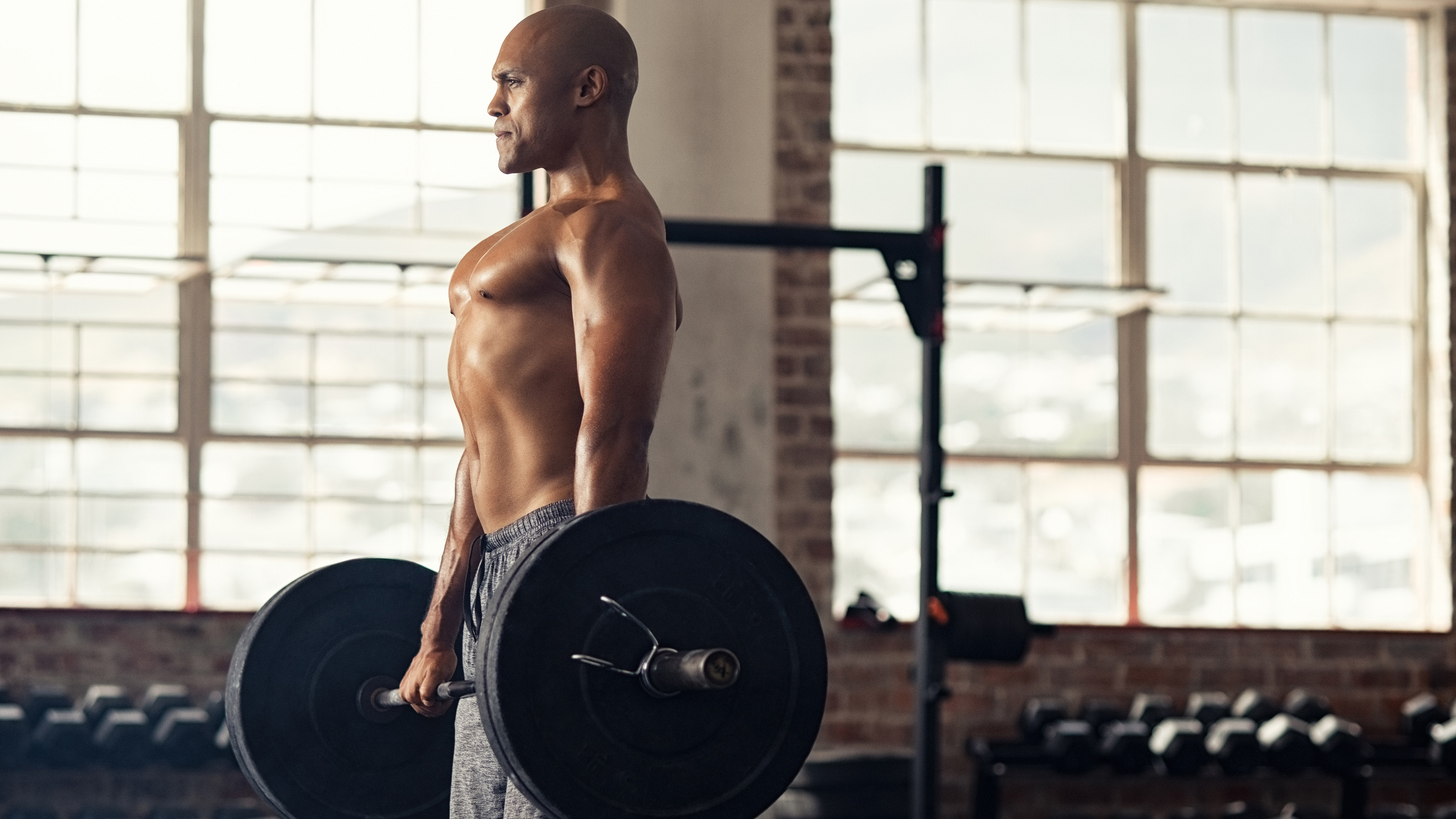

If you want to learn how to deadlift correctly, you are in the right place. The King of Lifts is one of the best – if not the best – compound exercises to build overall strength and burn fat, all at the same time. No respectable weightlifter should exclude deadlifts from their workout routine, only if they want top ridiculed in the gym.
The idea is to work with large weights (the barbell is your friend here) when performing deadlifts – although please start small and work up – so the form is especially important. Perform deadlifts incorrectly, and what you'll get is a pulled back, not big arms and toned glutes. We can also give you tips on how to do deadlifts at home, in case you only have dumbbells in your home gym.
Should you include deadlifts in your workouts – and do it correctly – you will very soon see changes in your physique. The deadlift works almost all your muscles in your body, mainly your glutes (bum muscle), quads and hamstrings (thighs), but also your core (stabilisation), lower back, lats, traps and even the delts (shoulders ) and forearm, too.
The deadlift is a key part of our Big 5, a set of compound exercises that gives a full-body workout. Other exercises include the squat, bent over row, overhead press and, naturally, the bench press.
Apart from a barbell and some weight plates, you might also need a weightlifting belt to perform deadlifts safely. Learn what the difference is between leather and velcro lifting belts here: leather vs velcro weightlifting belts.
Ready to get into it? Let's start dead at the beginning.
How to deadlift: better be safe than sorry
As mentioned above, you shift large amounts of weights when doing deadlifts. Incorrect form can put tremendous amount of pressure on your body, especially your lower back. Keeping a straight back all the way through the movement is paramount, as well as focusing on the muscles as you lift – a thing that's called 'mind-muscle connection', or MMC.
Sign up to the T3 newsletter for smarter living straight to your inbox
Get all the latest news, reviews, deals and buying guides on gorgeous tech, home and active products from the T3 experts
Important: if you are new to weight lifting, start even the 'proper' lifting with smaller weights you can easily manage and work your way up slowly, over a period of days, weeks or even months. There is no need to rush; you won't impress anybody in the gym by pulling your back doing 120kg deadlifts. Be sensible and if you are ever in doubt, just ask. There are plenty of PTs lingering around in any commercial gym and also, most of the buff people in gyms are more than happy to give you advice – whether you ask for it or not, in many cases. Just be sensible.

Stick your bum out in the starting position and keep your back straight all the way through the movement
How to deadlift: the barbell deadlift
To perform a barbell deadlift, you need the barbell in front of your legs on the floor, legs shoulder width-apart. Grab the barbell with overhand or mixed grip, legs bent and your back straight, shoulders open. Before you lift, activate your core and focus your attention on your legs and glutes.
First, start pushing with your legs and glutes, driving the bar up your legs. The barbell stays close to the body all the way through the movement. Once the bar goes past your knees, straighten your back gradually until you are fully stood up. It is very important for your back to stay straight all the way. Don't hunch your shoulders and don't slump. Open up the shoulders nice and wide at the apex of the movement.
On the way down, bend your hip until the barbell passes your knees, then bend your knees and place the barbell down. Never just bend your back fully as you place the barbell down. That's the fastest route to the spinal ward.
Barbell deadlift: alternatives
Sumo deadlifts are very similar to standard barbell deadlifts but you use a wider stance which reduces the range of motion (slightly). In return, the sumo deadlift attacks your muscle differently, helping you get out of that workout rut you got yourself into because you only do the same four exercises every time you work out.
Kettlebell single-leg deadlift
Perfect for home gym environments, this unilateral move will work the same muscles as the barbell deadlift in a space-friendly way.
Dumbbell deadlift
Same as the barbell deadlift but as opposed to holding one barbell, you use two dumbbells and perform the exercise that way. In theory, it's possible for the two dumbbells to be as heavy as a barbell but it's more likely that you will need to do more reps in each set to achieve similar results than the barbell deadlift.
Rack pull
You'll need a power rack (a.k.a. squat rack) to perform rack pulls. This limits the motion of the barbell but is more gentle on the lower back.
Romanian (or stiff-legged) deadlift
Not quite the same as the standard deadlift, the RDL (a.k.a. undead-lift) puts more emphasis on the hamstrings but works more or less the same muscles.
Kettlebell swing
The kettlebell swing is one of the best plyo alternative to deadlifts and switching from deadlifts to swings every now and then can even help you progress faster with your deadlifts.
Want to build muscle? Eat your protein.
To avoid any injuries and to help recovery, keep an eye out on your protein intake and always stretch after your exercising sessions. And make sure you drink plenty of water as well. A decent gym water bottle doesn't cost all that much.
Bulking is a popular word among bodybuilders, it means putting on weight so your body can transform your carb and fat reserves into muscle mass. This definitely doesn't mean you can gorge yourself on pizza and pasta all day long, though.
Once you found your maintenance calorie level (if you have an office desk-based job and you are an average built male, that's around 2400 calories per day), eat 5-700 more calories on top of that, mainly more protein and good carbs. That should be plenty to fuel your body to gain more muscle (and not fat).
Supplement-wise, you only really need two: protein powder and creatine. The former will help in the muscle repair process and latter will boost performance. Both are safe to use and there is a wide variety of offerings so you can choose a flavour you prefer.
With creatine, we recommend you get the unflavoured variety because it mixes well with any liquid and you only need a small amount to keep your creatine levels saturated. This means you can mix your 3-5 grams of creatine with anything in the morning (water, juice, even coffee) without having to worry about an aftertaste.
T3's how-to exercise guides
- How to do thrusters: this squat variant is a leg day staple AND a one-move full body exercise
- How to use an ab roller: get a six pack FAST with this cheap home gym staple
- Chin up vs pull up: what's the difference, muscles worked and WHAT IS THE BEST ONE?
- How to do ab crunches for beginners: the best stomach exercises to tone up
- How to do hardstyle planks: try this plank variation for quicker summer body six-pack gains
- How to do burpees: master this much loved/hated full-body cardio exercise easily
- How to do renegade rows: this upper back exercise also smokes the core, biceps AND shoulders too

Matt Kollat is a journalist and content creator who works for T3.com and its magazine counterpart as an Active Editor. His areas of expertise include wearables, drones, fitness equipment, nutrition and outdoor gear. He joined T3 in 2019. His byline appears in several publications, including Techradar and Fit&Well, and more. Matt also collaborated with other content creators (e.g. Garage Gym Reviews) and judged many awards, such as the European Specialist Sports Nutrition Alliance's ESSNawards. When he isn't working out, running or cycling, you'll find him roaming the countryside and trying out new podcasting and content creation equipment.
-
 Google Pixel Watch 3 just got a potentially life-saving update in the US
Google Pixel Watch 3 just got a potentially life-saving update in the USThe latest update brings advanced heart monitoring to American wrists
By Matt Kollat Published
-
 3 overrated shoulder exercises, according to a fitness expert (and what to do instead)
3 overrated shoulder exercises, according to a fitness expert (and what to do instead)Sculpt 3D shoulders whilst minimising injury with these three alternative exercises
By Bryony Firth-Bernard Published